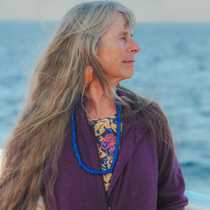In the wee hours of the morning, the SEA LION began her passage through Seymour Narrows traveling over Ripple Rock. These Narrows, were once considered one of the worst impediments to navigation in the Pacific Northwest. Today, ships still prefer to make this passage during slack waters, though the large rock pinnacle was blasted in 1958 taking it from nine feet below the surface of the water to forty feet below the surface.
The first light of the day found the SEA LION moving just north of Seymour Narrows while the morning sky began filling with light. As our expedition leader made his wake up call at 7:00 AM, our world was filled with glorious sunshine! Temperatures were cool, but the sunlight on the spectacular scenery was breathtaking. Just after breakfast many of us made our way to the bow in hopes of good sightings…visibility was perfect, and soon our wishes were granted. Pacific white-sided dolphins were spotted, “pushing water,” as our marine mammal specialist exclaimed over the PA. The SEA LION slowed and made a complete turn, heading south moving slowly towards this group of feeding dolphins. We were located in Johnstone Straight between Cracroft Island and Vancouver Island. During the next hour we watched as these marine mammals roster-tailed through the water obviously herding their prey. Then, they began milling about, showing some interest in the SEA LION . These beautifully patterned animals came all around the ship, dipping under the bow, some even bow riding, others following in our wake leaping from the water as if dancing on the tips of the waves left behind our vessel.
We were located about twenty miles east of our afternoon destination leaving us plenty of time to continue our exploration of the surrounding area searching for more marine mammals. In the meantime, announcements were made to adjourn to the forward lounge for the presentation of a film, “To Rise Again.” In preparation for our afternoon in the Kwakwaka’wakw community of Alert Bay, the film would tell the story of the rebuilding of the Big House, a central building in many Northwest Coast Native communities, where the culture continues through dance, song, speeches, and storytelling.
During lunch the SEA LION finished tying-up to the public dock in Alert Bay. Once the gangway was in place we could disembark and walk leisurely through town on our way to the U’Mista Cultural Center, where Lillian Hunt guided us through a Potlatch Collection of masks and coppers. The Canadian Government removed this collection during a potlatch in 1921. This was a time when pots latching along with many of the practices within Native culture were outlawed in British Columbia. As these laws changed the Kwakwaka’wakw people of Alert Bay petitioned the Canadian government for the return of the Potlatch regalia. The Canadian government responded, but with the condition that a museum be built to house the Potlatch Collection. The people of Alert Bay built the museum, and when it came time to name their new museum and cultural center the elders of the community were consulted. In the Kwakwaka’wakw culture when items were stolen usually during a raiding party, those items could be returned once a ransom or u’mista was paid. And so the Cultural Center and Museum in Alert Bay received its name, and became a box of treasures for everyone in the community. A place where people bring their children to teach them about the past, while walking in a building built in the present, and with the technology of today, the cultural values so important to the Native peoples of Alert Bay will be preserved for the future.
Once our tour of the museum was completed, we made our way, a short distance through town, to the Big House for a special presentation by the Tsasala Cultural Group. One of the founders, Andrea Cranmer gave an introduction to the Big House and a thorough overview of the dances we were about to see performed. As the afternoon light sifted through the smoke hole in the top of the Big House we listened to the rich singing of two young men seated at the ceremonial drum log, and watched as several generations of Kwakwaka’wakw people circled the central fire just as their ancestors had done before them…..and in the faces of the elders gracefully dancing around and around we saw the stories, unfolding in dance steps….and in the faces of the children we could see the next generation preparing to carry on, that same expression of joy.




